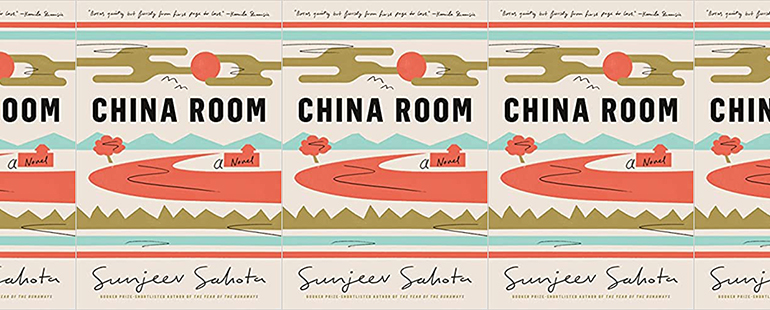Intergenerational Love and Oppression in Sunjeev Sahota’s China Room

China Room
Sunjeev Sahota
Viking | July 13, 2021
Sunjeev Sahota’s third novel, China Room, inspired by his own family history, tells the story of generational trauma, resistance, and the inner quest for repair. Spanning from 1929 to 1999, the book alternates between an unnamed young man and his great grandmother, Mehar—two characters who Sahota knows intimately. A photo in the back of the book shows an elderly woman holding a newborn baby boy, presumably Sahota. In the book, the great grandmother lives through British colonial rule and an era of strict gender norms which greatly limited the freedom of Punjabi women. Decades later, the baby boy grows up in England, confronting anti-immigrant hatred.
The novel begins with Mehar’s story set in Kala Sanghian on a farm in 1929. At fifteen, Mehar is trying to figure who her husband is. She’s just been married in a group wedding—three young girls married to three brothers close in age with similar features. In a pitch-black windowless hut, all Mehar feels is fear and her new husband’s callused hands. Her husband is not unkind, “neither rough nor gentle.” She can barely make out his outline. Sahota creates these scenes in an omniscient voice, creating a sense of intimacy, allowing readers to quickly develop a tenderness and love for Mehar.
It soon becomes clear that Mehar’s most immediate role as a wife is to give her unknown husband a son. Mai, her mother-in-law, decides where she sleeps at night. When Mehar isn’t asked to sleep in the hut, she sleeps next to her new sisters—Harbans and Gurleen—in a room called the China Room, named for the set of six decorated plates displayed on a high shelf that was a part of Mai’s wedding dowry many years ago. None of the girls knows which brother they’re married to. “Mine called me a big strong girl,” Harbans says, adding that he also slaps her behind. They laugh together. Mehar is the most eager to know which brother she belongs to. She’s curious, playful, and, as it turns out, brave. She summons the courage to ask Mai, who responds “Are you certain I send the same son to you each time?”
The novel’s early chapters are thickened with this air of secrecy and cruelty. With a flair for building tension, Sahota creates a dance between power and powerlessness. A few years before the marriage, Mai travels to Mehar’s family home to see how her future daughter-in-law is fairing in puberty. As they walk together, Mai wants to know if the eleven-year-old girl has gotten her period. In a swift movement, Mai pushes Mehar against a stone wall. “She felt Mehar’s breasts, coarsely, squeezing them hard through the tunic, using all her fingers and the heel of her palm.” Mai tells Mehar that she must wrap a cloth around her breasts, “tight as your cunt. They must be kept small. We’re not a family of obscenities.” Mehar must be modest and do as she’s told. But later in the novel, we learn that her independent spirit and sexual desires cannot be crushed by Mai’s cruelty, as Mehar’s love for the wrong brother becomes an act of resistance, a form of power she will never relinquish.
When the plot jumps forward to England in 2019, the point of view switches to Mehar’s great-grandson, who grew up in a small English town as a first-generation immigrant. As a grown man, he returns to the family’s home to care for his father after knee surgery. His father’s prescribed Codeine, causing the unnamed narrator to remember when he was eighteen and addicted to heroin in 1999. From that point on, the chapters toggle between Mehar’s disintegrating marriage and the young man’s struggle to recover, some of which takes place in the China Room, where his family sends him to get better.
Here, the man confronts his great grandmother’s life—a life which was fortified with metal bars to prevent her from escaping when the brother she loves is disbanded from the home. As the young man recovers, gaining enough energy to paint the old house, he removes the bars in the China Room, so he can sleep in the room his grandmother once slept in. It’s a beautiful symbolic gesture that speaks to how one generation seeks to repair the deep wounds and injustices inflicted on the preceding generations.
The ghost of his grandmother helps the man to heal, but healing is never that easy. Sahota movingly writes: “Now, twenty years on, I smile to think of him, to remember the eighteen-year-old who didn’t appreciate how things resurface, who couldn’t know that he would relapse twice, recover twice, that the underlying hurt does not go away and can only be paid attention to.” Mehar is punished for falling in love with the wrong brother, and her great-grandson punishes himself with addiction out of a sense of despair and hopelessness. Repair comes from the union of these two storylines, this connection between great grandmother and great-grandson. A frayed rope of connection crosses continents and generations, and the human need to survive persists.
In the end, the narrator is a better man because of his great grandmother, sharing her strong will and open heart. But Sahota resists the cliché that love heals all wounds—when wounds are this deep, it cannot. The scope of the novel—from 1929 to 2019—shows how much oppression holds fast. What intergenerational love does provide is a path towards self-knowledge, a catalyst to protect the sacred stories of family, and the desire to impart on the next generation new ideas, new hope, and a new path for moving forward towards freedom. China Room is a deeply captivating and necessary novel.

